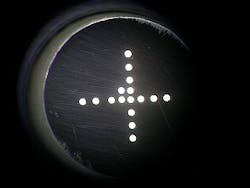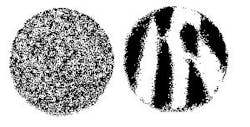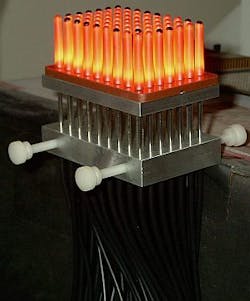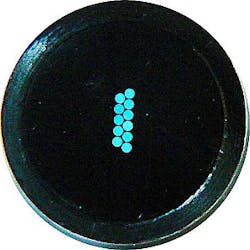FIBER-OPTIC ILLUMINATION: New sources and fibers combine to deliver flexible fiber-optic lighting
SANFORD STARK and TODD JOHNSON
Using optical fibers as a light source is a convenient way to get light to where it is needed. And by extension, those same fibers can be used for picking up reflected light and transporting it to various sensing elements for analysis. Although the principles of “light guides” were already known in the mid-19th century, practical applications would have to wait until the late 1950s when glass fibers (mostly borosilicate with a bandwidth from 400 nm to 1.5 μm and 50 μm diameter) became available in volume and at reasonable prices.
The first applications focused on bundling fibers to get light “from A to B” by means of a flexible optical connection between a light source such as an incandescent lamp to its destination—a workstation, microscope stage, or a readout array for a punched card in “Hollerith” card readers. The advantages of optical-fiber-based illumination are obvious: “cold” and very well defined, shadowless ringlights with mechanically flexible (gooseneck) positioners for workstations instead of warm/hot incandescent-lamp-based illumination. For early computer peripheral applications, then dominated by ancient technologies such as card- and paper-tape-based input/output technology, the concept of feeding light from a central light source to multiple locations precisely where needed was embraced because the miniature incandescent light arrays used in such applications had unpredictable aging rates, did not last very long, and were difficult to service.
Marks on cards could be read easily by guiding the light reflected from a card or sheet of paper back to a sensor through a second bundle integrated with the light-carrying fibers, very close to the surface with the mark. The light footprint of the probe could be shaped geometrically to optimize the contrast obtained between a mark and a space, such as a skinny rectangle. Moreover, marks could be printed or manually applied such as in the ubiquitous “Scantron” readers.
As a result of these successes, various illumination and reflective probe schemes found their way into myriad applications and a versatile and thriving fiber-optic manufacturing base developed. The light-emitting diodes (LEDs) that appeared later on the scene turned out to be perfect companions, amplifying the usefulness and versatility of light guides.
Fiber types and illumination sources
Borosilicate fibers are adequate for most illumination applications. They are mechanically
flexible, versatile, readily available, and can easily be processed into light sources or probes and will cover wavelengths from roughly 400 nm to 1.5 μm. However, there are multiple fiber types available today for specialized use (see table). For near-ultraviolet (UV) wavelength applications, it is necessary to use more expensive and less flexible quartz (silica) fibers, with a low end of 180 nm for short distances. Polyamide cladding allows a reasonable bending radius of the fragile quartz. For somewhat longer wavelengths, water-free (low hydroxyl) quartz can be used (600 nm to 2.1 μm). For mid-infrared (IR) applications, chalcogenide glasses cover the range from 1 to 12 μm, with chlorine chalcogenide fibers the basis for a number of IR chemical sensor systems. Chalcogenide non-oxide glasses as IR optical materials became available with the development of a commercial process to produce arsenic sulfide (As2S3) glass for forward-looking IR (FLIR) cameras.
| Fiber Type | Transmission wavelength range |
| UV silica | 180 nm to 1.15 μm |
| Sapphire | 200 nm to 3.5 μm |
| Zirconium fluoride | 450 nm to 5.0 μm |
| Water-free (low-OH) silica | 580 nm to 1.95 μm |
| Germanium oxide | 1.0 to 3.25 μm |
| C2 chalcogenide | 1.5 to 7.0 μm |
| Selenium fiber | 1.5 to 10 μm |
| C1 chalcogenide | 2.0 to 11 μm |
| C3 chalcogenide | 2.0 to 6.0 μm |
| Silver halide | 4.0 to 18 μm |
The disadvantages of incandescent lights are well known: inefficient, short lifetime, change in light intensity with time, and change of color temperature with light intensity. Multidie LED-based light sources are now available that are equal in intensity to halogen lights. The advantages are a life expectancy more than an order of magnitude better than halogen (up to 50,000 hours), light wavelength(s) that can be precisely selected by the choice of the LEDs, and no frequency change with intensity levels. Of particular interest are multiplefrequency LED light sources that can be combined into a single fiber-optic illuminator to deliver light sequentially or combined for excitation/emission mapping in fluorescence, ultralow stray light absorbance measurements, material analysis, and other applications. They can be software controlled for particular measuring sequences, strobing, and intensity levels.
UV curing
Ultraviolet light curing of single-part adhesives is popular within the manufacturing sector due to the rapid curing time and high bond strength. Light-curing adhesives can cure in as little as a second and many formulations can bond dissimilar substrates (materials) and withstand harsh temperatures. These qualities make UV-curing adhesives essential to the manufacturing of items in industrial markets such as electronics, telecommunications, medicine, aerospace, and dentistry.
Currently, UV lights are bulky, need cooling as well as concentrating optics, and would be very impractical to use, for example, in dentistry applications. A fiber-optic bundle is a convenient way to pick up the light from the lamp/optics and transmit it in the form of a light guide to the handheld “trigger” device—well known (unfortunately) for curing fillings or securing a dental crown. The fibers used for this purpose are regular 50 μm core diameter borosilicate types that are more than adequate to transmit the wavelengths required.
Recently, LEDs have become available for the longer UV wavelengths with power densities and efficiencies >20% @ 400 nm. Discrete, high-output LED arrays that operate from 365 to 400 nm are already commercially available. Due to the relative inefficiency of coupling LEDs into fibers, UV-curing stations with light guides are not yet available. The output levels from UV LEDs will undoubtedly increase and single-source, multiple-spot curing systems for “difficult places” will be possible.
Reflective probes
Fiber-optic strands can easily be combined into bundles where some strands transmit light to the tip and others pick up the reflected light for distribution to a sensor. Conversely, a bundle can be split (bifurcated) for the same purpose. Combined with an adequate light source such as LEDs and appropriate sensors including standard photodiodes, avalanche photodiodes, and photomultipliers, this configuration constitutes a basic reflective probe.
Such probes can be very small (with just a few 50 μm core diameter fibers), very long (up to tens of meters removed from the light source and detector), intrinsically safe (no electrical current), able to withstand very high (up to 500°C) and very low (a few K) temperatures, and will work fine in a hard vacuum, and have no problems with high pressure (see Fig. 3). There is also no upper limit to the size. Probes with a 2.5 in.2 aperture, combining 16 discrete light input bundles, have been manufactured.The bifurcation can be mapped with designated strands as emitters surrounding the pickup strands or vice versa. Also possible are alternate layers with arbitrary widths—source/sensor/source—which are useful when picking up information presented lengthwise such as reading absolute position marks on hydraulic pistons with a charge-coupled-device (CCD) array coherently coupled into the sensing layer and the source layers fed by an LED.
Another technique is randomized bifurcation, which has some distinct advantages as every single sensing fiber will find a source fiber as neighbor. This will allow closer proximity to the surface to be sensed and tighter coupling. Of course, there is no reason to stop at just bifurcation. Very often, sources with more than one wavelength are required, a separate feedback channel to keep the light constant is useful, and multiple sensors or detectors are sometimes necessary. “Multifurcated” probes are used in oximetry, where the reflected light from two light sources with different wavelengths (red and IR) are sequentially compared to measure blood oxygenation intravenously.Sanford Stark is president and Todd Johnson is engineering manager at Fiberoptic Systems Inc. (FSI), 60 Moreland Rd., Unit A, Simi Valley, CA 93065; e-mail: [email protected]; www.fiberopticsystems.com.




